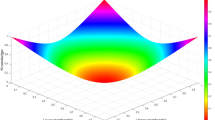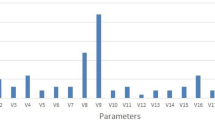Abstract
As combinations of neighborhood rough sets and multigranulation rough sets (MRSs), optimistic and pessimistic neighborhood MRSs can handle complex information systems and characterize problems from multiple perspectives. Nevertheless, they require complete inclusion between neighborhood granules and target concepts, which may weaken their fault tolerance. To overcome the challenge, this paper proposes neighborhood MRSs based on variable precision neighborhood (VMRSs), which allow a certain degree of misclassification and noise in data. In VMRSs, we assign different weights to different attribute subsets to distinguish their importance in learning. In addition to investigating the properties of the VMRS model, we focus on the methods of obtaining its required multiple attribute subsets and their weights. Next, we introduce two applications of the VMRS model. One is using it to construct an indicator for evaluating attribute clustering and attribute subset weighting methods. The other is employing it for attribute reduction. Based on distribution distances, we develop a heuristic algorithm framework for obtaining the proposed reducts. The mechanism and applications of VMRSs are explained through a case study on a medical diagnosis issue. Finally, the experiments on real datasets illuminate the effectiveness and superiority of the methods and algorithms in the paper.









Similar content being viewed by others
Data Availability
The datasets generated during and/or analysed during the current study are available from the corresponding author on reasonable request.
Notes
http://archive.ics.uci.edu/ml
References
Ba J, Liu KY, Ju HR, Xu SP, Yang XB (2022) Triple-G: a new MGRS and attribute reduction. Int J Mach Learn Cyb 13(2):337–356
Chen JY, Zhu P (2023) A variable precision multigranulation rough set model and attribute reduction. Soft Comput 27:85–106
Chen Y, Liu KY, Song JJ, Fujita H, Yang XB, Qian YH (2020) Attribute group for attribute reduction. Inform Sci 535:64–80
Chen Y, Wang PX, Yang XB, Mi JS, Liu D (2021) Granular ball guided selector for attribute reduction. Knowl-Based Syst 229:107326
Demšar J (2006) Statistical comparison of classifiers over multiple data sets. J Mach Learn Res 7:1–30
Fujita H, Gaeta A, Loia V, Orciuoli F (2020) Hypotheses Analysis and Assessment in counter-terrorism activities: a method based on OWA and Fuzzy Probabilistic Rough Sets. IEEE T Fuzzy Syst 28(5):831–845
Hu CX, Zhang L (2020) A dynamic framework for updating neighborhood multigranulation approximations with the variation of objects. Inform Sci 519:382–406
Hu M, Tsang ECC, Guo YT, Chen DG, Xu WH (2021) A novel approach to attribute reduction based on weighted neighborhood rough sets. Knowl-Based Syst 220:106908
Hu QH, Yu DR, Liu JF, Xu CX (2008) Neighborhood rough set based heterogeneous feature subset selection. Inform Sci 178(18):3577–3594
Hu QH, Yu DR, Xie ZX (2008) Neighborhood classifiers. Expert Syst Appl 34:866–876
Jaccard P (1912) The distribution of the flora in the alpine zone. New phytologist 11(2):37–50
Kosub S (2019) A note on the triangle inequality for the Jaccard distance. Pattern Recogn Lett 120:36–38
Li JH, Ren Y, Mei CL, Qian YH, Yang XB (2016) A comparative study of multigranulation rough sets and concept lattices via rule acquisition. Knowl-Based Syst 91:152–164
Lin GP, Qian YH, Li JJ (2012) NMGRS: Neighborhood-based multigranulation rough sets. Int J Approx Reason 53(7):1080–1093
Liu JH, Lin YJ, Du JX, Zhang HB, Chen ZY, Zhang J (2022) ASFS: A novel streaming feature selection for multi-label data based on neighborhood rough set. Appl Intell: 1–18
Liu KY, Li TR, Yang XB, Yang X, Liu D (2022) Neighborhood rough set based ensemble feature selection with cross-class sample granulation. Appl Soft Comput 131:109747
Liu KY, Li TR, Yang XB, Yang X, Liu D, Zhang PF, Wang J (2022) Granular cabin: An efficient solution to neighborhood learning in big data. Inform Sci 583:189–201
Luo S, Miao DQ, Zhang ZF, Zhang YJ, Hu SD (2020) A neighborhood rough set model with nominal metric embedding. Inform Sci 520:373–388
MacQueen J (1967) Some methods for classification and analysis of multivariate observations. Proc fifth Berkeley Symp Mathematical Statistics and Probability 1(14):281–297
Mi JS, Wu WZ, Zhang WX (2004) Approaches to knowledge reduction based on variable precision rough set model. Inform Sci 159(3–4):255–272
Pawlak Z (1982) Rough sets. Int J Comput Inform Sci 11(5):341–356
Pawlak Z (1991) Rough sets: Theoretical Aspects of Reasoning about Data. Kluwer Academic Publishers, Boston
Qian J, Hong CX, Yu Y, Liu CH, Miao DQ (2022) Generalized multigranulation sequential three-way decision models for hierarchical classification. Inform Sci 616:66–87
Qian YH, Cheng HH, Wang JT, Liang JY, Pedrycz W, Dang CY (2017) Grouping granular structures in human granulation intelligence. Inform Sci 382–383:150–169
Qian YH, Li SR, Liang JY, Shi ZZ, Wang F (2014) Pessimistic rough set based decisions: a multigranulation fusion strategy. Inform Sci 264:196–210
Qian YH, Liang JY (2006) Rough Set Method Based on Multi-Granulations. 2006 5th IEEE International Conference on Cognitive Informatics. IEEE 1: 297–304
Qian YH, Liang JY, Dang CY (2009) Incomplete multigranulation rough set. IEEE Trans Syst Man Cybern-Part A: Systems and Humans 40(2):420–431
Qian YH, Liang JY, Yao YY, Dang CY (2010) MGRS: a multi-granulation rough set. Inform Sci 180(6):949–970
Qian YH, Liang XY, Lin GP, Guo Q, Liang JY (2017) Local multigranulation decision-theoretic rough sets. Int J Approx Reason 82:119–137
Robnik-Šikonja M, Kononenko I (2003) Theoretical and empirical analysis of ReliefF and RReliefF. Mach learn 53(1):23–69
Shu WH, Qian WB, Xie YH (2022) Incremental neighborhood entropy-based feature selection for mixed-type data under the variation of feature set. Appl Intell 52:4792–4806
Sun L, Zhang XY, Qian YH, Xu JC, Zhang SG, Tian Y (2019) Joint neighborhood entropy-based gene selection method with fisher score for tumor classification. Appl Intell 49:1245–1259
Wang CZ, Hu QH, Wang XZ, Chen DG, Qian YH, Dong Z (2018) Feature selection based on neighborhood discrimination index. IEEE Trans Neural Netw Learn Syst 29(7):2986–2999
Wang CZ, Shao MW, He Q, Qian YH, Qi YL (2016) Feature subset selection based on fuzzy neighborhood rough sets. Knowl-Based Syst 111:173–179
Wang CZ, Shi YP, Fan XD, Shao MW (2019) Attribute reduction based on k-nearest neighborhood rough sets. Int J Approx Reason 106:18–31
Wilcoxon F (1945) Individual comparisons by ranking methods. Biometrics 1:80–83
Wilson DP, Martinez TR (1997) Improved heterogeneous distance functions. J Artif Intell Res 6:1–34
Xu WH, Yuan KH, Li WT (2022) Dynamic updating approximations of local generalized multigranulation neighborhood rough set. Appl Intell 52:9148–9173
Xu ZB, Liang JY, Dang CY, Chin KS (2002) Inclusion degree: a perspective on measures for rough set data analysis. Inform Sci 141:227–236
Yang X, Li MM, Fujita H, Liu D, Li TR (2022) Incremental rough reduction with stable attribute group. Inform Sci 589:283–299
Yang XB, Liang SC, Yu HL, Gao S, Qian YH (2019) Pseudo-label neighborhood rough set: Measures and attribute reductions. Int J Approx Reason 105(2019):112–129
Yang XB, Qi YS, Song XN, Yang YY (2013) Test cost sensitive multigranulation rough set: Model and minimal cost selection. Inform Sci 250:184–199
Yang XL, Chen HM, Li TR, Wan JH, Sang BB (2021) Neighborhood rough sets with distance metric learning for feature selection. Knowl-Based Syst 224:107076
Yao YY (2019) Three-way conflict analysis: Reformulations and extensions of the pawlak model. Knowl-Based Syst 180:26–37
Yao YY, She YH (2016) Rough set models in multigranulation spaces. Inform Sci 327:40–56
Yao YY, Zhao Y, Wang J (2008) On reduct construction algorithms. Trans Comput Sci 2:100–117
Zadeh LA (1997) Toward a theory of fuzzy information granulation and its centrality in human reasoning and fuzzy logic. Fuzzy Sets Syst 90(2):111–127
Zhang D, Zhu P (2022) Variable radius neighborhood rough sets and attribute reduction. Int J Approx Reason 150:98–121
Zhu P (2011) An axiomatic approach to the roughness measure of rough sets. Fund Inform 109(4):463–480
Zhu P, Wen QY (2012) Information-theoretic measures associated with rough set approximations. Inform Sci 212:33–43
Acknowledgements
The authors would like to thank the anonymous reviewers and Editor for their insightful comments and suggestions which greatly improve the quality of this paper. This work was supported by the National Natural Science Foundation of China under Grant 62172048.
Author information
Authors and Affiliations
Corresponding author
Ethics declarations
Conflicts of interests
The authors declare no conflict of interest.
Additional information
Publisher's Note
Springer Nature remains neutral with regard to jurisdictional claims in published maps and institutional affiliations.
Rights and permissions
Springer Nature or its licensor (e.g. a society or other partner) holds exclusive rights to this article under a publishing agreement with the author(s) or other rightsholder(s); author self-archiving of the accepted manuscript version of this article is solely governed by the terms of such publishing agreement and applicable law.
About this article
Cite this article
Chen, J., Zhu, P. A multigranulation rough set model based on variable precision neighborhood and its applications. Appl Intell 53, 24822–24846 (2023). https://doi.org/10.1007/s10489-023-04826-8
Accepted:
Published:
Issue Date:
DOI: https://doi.org/10.1007/s10489-023-04826-8




